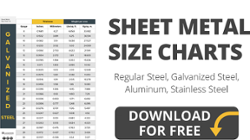Stainless steel sheet metal is one of the most versatile building materials out there.
Not only is it durable and affordable, it is also relatively easy to work with. It can be used in projects ranging from huge industrial applications to intricate electronics applications, and just about everything in between.
Here’s everything you need to know about working with stainless steel in applications that require sheet metal fabrication:
Properties of Stainless Steel Sheet Metal
1. It’s shiny and tough.
Stainless steel is a steel alloy that contains at least 10.5% chromium. The chromium content is what gives the metal its anti-corrosion and anti-staining properties. The actual chromium content, along with the carbon content and the content of other metals, varies based on the application in which the steel will be used.
It should be noted that stainless steel is not completely corrosion or stain proof. The resistance of the metal will depend on its content, and certain chemicals can damage the metal regardless of its content. However, stainless offers some of the best corrosion and stain resistance available, especially when you consider the other qualities it offers (aesthetics, durability, etc.).
2. The sheets range in thickness up to ¼ inch.
Stainless steel sheet metal can be quite thin, but for it to qualify as “sheet metal” it only reaches a ¼ inch in thickness -- after that, the metal is referred to as “plate.” The thickness of and stainless sheet metal is measured by gauge. The higher the gauge number, the thinner the sheet.
You can reference sheet metal size charts and use a gauging tool to measure your material.
3. There are a variety of choices based on your needs.
Stainless steel sheet metal comes in a variety of configurations, each with advantages and disadvantages. Manufacturers may offer different grades, finishes and sizes, but the types tend to be standard across manufacturers. These types include:
- 200 Series Austenitic – This series is made of chromium, carbon, manganese, and/or nickel. It’s possible to harden this series, but one drawback is its lack of resistance to corrosion.
- 300 Series Austenitic – Between the 200 series and 300 series, austenitic stainless steel makes up around 70% of all stainless steel produced. The 300 series is the most ductile, weldable, and corrosion-resistant of all stainless steel types. The most popular grade is 304, often named A2 stainless. The 18% chromium content and 8% nickel content also leads to 304 being referred to as 18/8.
- Martensitic – This type is very strong and easy to machine, but it is less resistant to corrosion.
- Ferritic – Preferred for its ease of engineering, ferritic stainless is less corrosion-resistant than austenitic.
- Duplex – This up-and-comer is approximately 50/50 between austenitic and ferritic. It’s about 2x as strong as austenitic.
How Easy Is It to Manipulate Stainless Steel?
Working with stainless steel sheet metal is relatively easy in many ways, although there are challenges depending on what you’re trying to do and the grade you’re using.
For instance, thin sheets require care when welding to avoid warping or burning, while thick sheets can be difficult to bend. Cutting sheets usually isn’t difficult as long as you work with a vendor who has the right tools -- like a state-of-the-art laser cutter machine
Welding
The two biggest difficulties with welding stainless steel sheet metal are metal thickness and heat distribution.
As with any thin metal sheet, applying too much heat too quickly will warp the metal, and there is always a risk of burn through. MIG welding gives you a good deal of control over the heat you apply, but your manufacturer will still need to brace the weld appropriately and use plenty of tacks to keep it in place. Your engineer should spread the heat out and allow the metal to cool as needed.
Bending
The thinner the sheet, the easier it is to bend. Thin sheets can be bent by hand, while thicker sheets will require a bending tool.
Cutting
These days, sheets can be cut using high-tech lasers [insert link here later]. For the stubbornly old-fashioned, there are still metal snips, a hacksaw, jigsaw or a band saw. Always file off burs before handling.
Which Applications & Industries Is Stainless Best For?
You only need to look around your kitchen or downtown to see all the many ways stainless steel sheet metal is used. Because it comes in so many thicknesses and types,.it can be used in:
- Architecture
- Construction
- Automotive
- Medical
- Food service
- Heavy industry (manufacture of large/heavy goods and materials in bulk)
- Energy
Any Hesitations?
Machinable, customizable and often beautiful, stainless steel sheet metal is the material of choice for countless applications. If you’re unsure you want to deal with the comparatively high cost compared with lesser steels or aluminum, ask a sheet metal fabricator. An experienced vendor can tell you whether your project really needs the highly aesthetic and protective qualities of stainless or if you can get away with something else.


